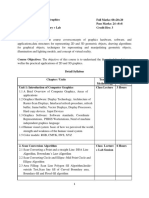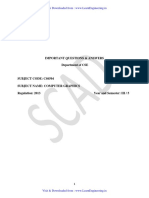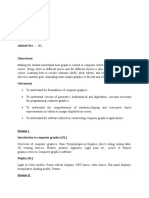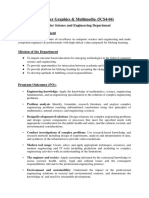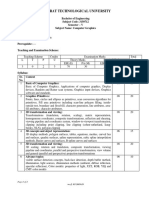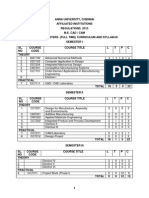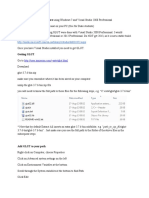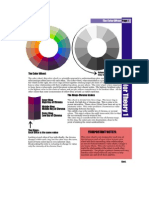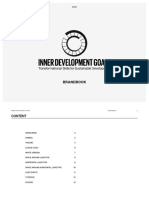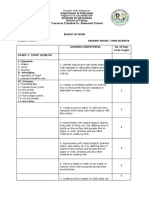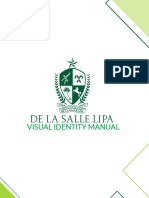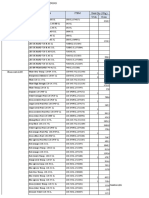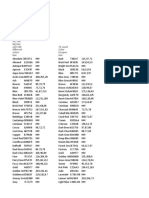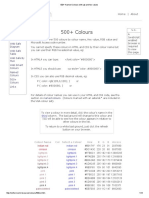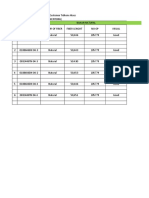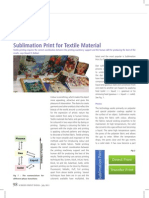S.K.
P INSTITUTE OF TECHNOLOGY
Tiruvannamalai 606 611
_
COURSE FILE DETAILS
Prepared by the Faculty
G.Rajasekaran
Designation
Assistant Professor
Department
Computer Science and Engineering
Name of the Course
Branch
Batch
Computer Science and Engineering
2012-2016
Semester
Title of the subject
Subject code
Prepared by: G.Rajasekaran
B.E
VII
Computer Graphics
CS2401
Verified by : HOD
Approved by:PRINCIPAL
�S.K.P INSTITUTE OF TECHNOLOGY
Tiruvannamalai 606 611
_
TARGET, COURSE PLAN AND EVALUATION METHOD
1. Name of the Faculty
: G.Rajasekaran
2. Subject
: Computer Graphics
3. Subject Code
: CS2401
4. Branch
: B.E (CSE)
1. TARGET
a) Pass Percentage
: 100%
b) 1st Class Pass Percentage
: 75%
2. COURSE PLAN
Coverage of units by lectures, design experiments, demonstration of models,
model preparation, assignments etc.
3. METHOD OF EVALUATION
a) CIAT-1
b) CIAT-2
c) MODEL EXAM
d) Assignments
Signature of the Faculty
Prepared by: G.Rajasekaran
Signature of the HOD
Verified by : HOD
Signature of the Principal
Approved by:PRINCIPAL
�S.K.P INSTITUTE OF TECHNOLOGY
Tiruvannamalai 606 611
_
COURSE OBJECTIVE
1. Name of the Faculty
: G.Rajasekaran
2. Subject
: Computer Graphics
3. Subject Code
: CS2401
4. Branch
: B.E (CSE)
5. On completion of this subject the student shall be able to
S.No Objective
The objectives of this lesson are to make the
1
Outcome
A- An ability to apply knowledge of mathematics, science,
student aware of the following concepts
and engineering
a) points and lines
C-An ability to design a system, component, or process to
b) Rasterization
meet desired needs within realistic constraints such as
c) DDA and Bresenhams algorithm
economic, environmental, social, political, ethical and safety,
d) Properties of circle and ellipse
Manufacturability and sustainability
Using 2D coordinates - geometric
D-An ability to function on multi-disciplinary teams
transformation.
E-An ability to identify, formulate, and solve engineering
problems
To get the idea and learn the concepts in,
J-A knowledge of contemporary issues
A- An ability to apply knowledge of mathematics, science,
3D Model Respresentation.
and engineering
Using 3D coordinates - geometric
C-An ability to design a system, component, or process to
transformation.
meet desired needs within realistic constraints such as
3D Projections, Visible Surface Rendering
economic, environmental, social, political, ethical and safety,
Methods.
Manufacturability and sustainability
D-An ability to function on multi-disciplinary teams
E-An ability to identify, formulate, and solve engineering
problems
The aim of this lesson is to learn the concept of,
J-A knowledge of contemporary issues
A- An ability to apply knowledge of mathematics, science,
Color Models( RGB,YIQ,CMY,HSV) and
and engineering
OpenGL.
C-An ability to design a system, component, or process to
meet desired needs within realistic constraints such as
economic, environmental, social, political, ethical and safety,
Manufacturability and sustainability
D-An ability to function on multi-disciplinary teams
Prepared by: G.Rajasekaran
Verified by : HOD
Approved by:PRINCIPAL
�S.K.P INSTITUTE OF TECHNOLOGY
Tiruvannamalai 606 611
_
E-An ability to identify, formulate, and solve engineering
problems
J-A knowledge of contemporary issues
K - An ability to use the techniques, skills, and modern
engineering tools necessary for engineering practice
4.
The objectives of this lesson are to make the
A- An ability to apply knowledge of mathematics, science,
student aware of the following concepts
and engineering
a) classification of surface detection algorithms
C-An ability to design a system, component, or process to
b) Back face detection and
meet desired needs within realistic constraints such as
c) Depth buffer algorithms
economic, environmental, social, political, ethical and safety,
Manufacturability and sustainability
E-An ability to identify, formulate, and solve engineering
problems
J-A knowledge of contemporary issues
K - An ability to use the techniques, skills, and modern
engineering tools necessary for engineering practice
5.
The objectives of this lesson are to make the
A- An ability to apply knowledge of mathematics, science,
student aware of the following concepts
and engineering
a) classification of Fractals
C-An ability to design a system, component, or process to
b) Ray Tracing
meet desired needs within realistic constraints such as
c) Adding Surface Structures
economic, environmental, social, political, ethical and safety,
Manufacturability and sustainability
D-An ability to function on multi-disciplinary teams
E-An ability to identify, formulate, and solve engineering
problems
J-A knowledge of contemporary issues
K - An ability to use the techniques, skills, and modern
engineering tools necessary for engineering practice
COURSE OUTCOME
1. Name of the Faculty
: G.Rajasekaran
2. Subject
: Computer Graphics
3. Subject Code
: CS2401
Prepared by: G.Rajasekaran
Verified by : HOD
Approved by:PRINCIPAL
�S.K.P INSTITUTE OF TECHNOLOGY
Tiruvannamalai 606 611
4. Branch
: B.E (CSE)
5.The expected outcome of the subject are
S.No
A
B
C
Outcomes of the course
Applicable Out come
An ability to apply knowledge of mathematics, science, and engineering
of the subject
An ability to design and conduct experiments, as well as to analyze and
interpret data
An ability to design a system, component, or process to meet desired needs
within realistic constraints such as economic, environmental, social,
D
E
F
G
H
J
K
political, ethical and safety, Manufacturability and sustainability
An ability to function on multi-disciplinary teams
An ability to identify, formulate, and solve engineering problems
An understanding of professional and ethical responsibility
An ability to communicate effectively
The broad education necessary to understand the impact of engineering
solutions in a global, economic, environmental, and societal context
A knowledge of contemporary issues
An ability to use the techniques, skills, and modern engineering tools
necessary for engineering practice
Prepared by: G.Rajasekaran
Verified by : HOD
Approved by:PRINCIPAL
�S.K.P INSTITUTE OF TECHNOLOGY
Tiruvannamalai 606 611
_
Objectives-outcome relationship Matrix
Objectives
The objectives of this lesson are to make the
student aware of the following concepts
a) points and lines
b) Rasterization
c) DDA and Bresenhams algorithm
d) Properties of circle and ellipse
Using 2D coordinates - geometric
transformation.
To get the idea and learn the concepts in,
3D Model Respresentation.
Using 3D coordinates - geometric
transformation.
3D Projections, Visible Surface Rendering
Methods.
The aim of this lesson is to learn the
concept of,
Color Models( RGB,YIQ,CMY,HSV) and
OpenGL.
The objectives of this lesson are to make the
student aware of the following concepts
a) classification of surface detection
algorithms
b) Back face detection and
c) Depth buffer algorithms
The objectives of this lesson are to make the
student aware of the following concepts
a) classification of Fractals
b) Ray Tracing
c) Adding Surface Structures
Signature of the Faculty
SYLLABUS
Prepared by: G.Rajasekaran
Verified by : HOD
Approved by:PRINCIPAL
�S.K.P INSTITUTE OF TECHNOLOGY
Tiruvannamalai 606 611
_
CS2401
UNIT I
COMPUTER GRAPHICS
LTPC 3003
2D PRIMITIVES
Output primitives Line, Circle and Ellipse drawing algorithms - Attributes of output primitives Two
dimensional Geometric transformation - Two dimensional viewing Line, Polygon, Curve and Text
clipping algorithms
UNIT II
3D CONCEPTS
Parallel and Perspective projections - Three dimensional object representation Polygons, Curved
lines, Splines, Quadric Surfaces,- Visualization of data sets - 3D transformations Viewing -Visible
surface identification.
UNIT III
GRAPHICS PROGRAMMING
Color Models RGB, YIQ, CMY, HSV Animations General Computer Animation, Raster, Keyframe Graphics programming using OPENGL Basic graphics primitives Drawing three dimensional objects
- Drawing three dimensional scenes
UNIT IV
RENDERING
Introduction to Shading models Flat and Smooth shading Adding texture to faces Adding shadows
of objects Building a camera in a program Creating shaded objects Rendering texture Drawing
Shadows.
UNIT V
FRACTALS
Fractals and Self similarity Peano curves Creating image by iterated functions Mandelbrot sets
Julia Sets Random Fractals Overview of Ray Tracing Intersecting rays with other primitives
Adding Surface texture Reflections and Transparency Boolean operations on Objects.
TOTAL: 45 PERIODS
TEXT BOOKS:
1. Donald Hearn, Pauline Baker, Computer Graphics C Version, second edition, Pearson
Education,2004.
2. F.S. Hill, Computer Graphics using OPENGL, Second edition, Pearson Education, 2003.
REFERENCE:
1. James D. Foley, Andries Van Dam, Steven K. Feiner, John F. Hughes, Computer Graphics- Principles
and practice, Second Edition in C, Pearson Education, 2007.
Prepared by: G.Rajasekaran
Verified by : HOD
Approved by:PRINCIPAL
�S.K.P INSTITUTE OF TECHNOLOGY
Tiruvannamalai 606 611
_
STUDENTS NAME LIST
S.No
1
2
3
4
5
6
7
8
9
10
11
12
13
14
15
16
17
18
19
20
21
22
23
24
25
26
27
28
29
30
31
32
33
34
35
36
Reg. Number
512312104002
512312104003
512312104004
512312104005
512312104006
512312104007
512312104008
512312104009
512312104010
512312104011
512312104012
512312104013
512312104014
512312104016
512312104017
512312104018
512312104019
512312104020
512312104021
512312104022
512312104023
512312104024
512312104026
512312104027
512312104028
512312104029
512312104030
512312104031
512312104032
512312104034
512312104035
512312104036
512312104037
512312104038
512312104039
512312104041
Prepared by: G.Rajasekaran
Name of Student
N. ANAND
N. ANIESH KUMAR
R. ARIVAZHAGI
R.G. ARUNA
K. BAGYALAKSHMI
A.BALAKRISHNAN
P. BALASUBRAMANI
D.BHARATHAN
M.DHINAKARAN
P.EZHILARASI
A.H.FAIZAL BASHA
D.GAYATHRI
J.GOWTHAM
M.JAYAPRIYA
L.JERFIN JANCI RANI
V.KARTHIKEYAN
G.KOTTESHWARI
G.LAKSHMINARAYANAN
V.MALATHI
R.MONIKA
A.NANDHINI
G.PACHAYAMMAL
A.PRABHUDEVA
D.PRASHANTH
B.PRAVEENKUMAR
P.V.PREETHIESHWARI
A.PRINCY AUXILIA
P.PRIYA
G.PRIYADHARSHINI
P.PRIYANGA
R.RAJESHWARI
P.RAMPREETHI
M.RAMYA
L.RANJITHA
R.RANJITHA
ROOTH JOSEPH VIJAYMARY
Verified by : HOD
Approved by:PRINCIPAL
�S.K.P INSTITUTE OF TECHNOLOGY
Tiruvannamalai 606 611
_
37
38
39
40
41
42
43
44
45
46
47
48
49
50
51
52
53
512312104042
512312104043
512312104044
512312104045
512312104046
512312104047
512312104048
512312104049
512312104050
512312104051
512312104052
512312104053
512312104054
512312104055
512312104056
512312104057
512312104301
Prepared by: G.Rajasekaran
N.SAKTHIVEL
K.SANGEETHA
R.SARANYA
S.SATHISH
M.SATHIYASELVAM
R.SAVITHA
R.SELVAM
D.SINDHU
A.SUSILA
M.TAMIZHVELAN
K.UMA
M.VENKATESH
S.VETRISELVAN
V.VIGNESHVARAN
R.VIJAYALAKSHMI
R.VINOTH
R.PRABAKARAN
Verified by : HOD
Approved by:PRINCIPAL
�S.K.P INSTITUTE OF TECHNOLOGY
Tiruvannamalai 606 611
_
Lesson Plan
Unit I : Using primitives - line, circle, ellipse drawing algorithm.Output primitives Line,
Circle and Ellipse drawing algorithms - Attributes of output primitives Two dimensional
Geometric transformation - Two dimensional viewing Line, Polygon, Curve and Text clipping
algorithms
Objective:
The objectives of this lesson are to make the student aware of the following concepts
a) points and lines and Rasterization and
c) Properties of circle and ellipse and
S.No
b) DDA and Bresenhams algorithm
d) Using 2D coordinates - geometric transformation
Books
Topics to be covered
Referred
Date
29.06.2015
30.06.2015
No. of
Pages
Hours
Required
Introduction - Output Primitives
T1
004 - 034
Line Drawing Algorithm
T1
086 - 092
Circle Drawing Algorithm
T1
097 - 101
Ellipse Drawing Algorithm
T1
102 - 110
Attributes of Output Primritives
T1
144 - 176
Two Dimensional Geometric Transformation
T1
184 - 187
Two Dimensional Matrix Representation,
Composite Matrix, General Pivot Point
T1
188 - 203
Two Dimensional Viewing
T1
217 - 224
T1
225 - 246
Handouts
02.07.2015
3
03.07.2015
4
04.07.2015
5
6
7
8
9
06.07.2015
07.07.2015
08.07.2015
09.07.2015
10.07.2015
10
Line,Polygon,Curve and Text Clipping
Algorithms
Beyond the Syllabus: History of Computer
Graphics and Applications of Computer
Graphics
Total Number of Hours Planned
Prepared by: G.Rajasekaran
Verified by : HOD
10
Approved by:PRINCIPAL
�S.K.P INSTITUTE OF TECHNOLOGY
Tiruvannamalai 606 611
_
Unit II : Parallel and Perspective projections - Three dimensional object representation Polygons,
Curved lines, Splines, Quadric Surfaces,- Visualization of data sets - 3D transformations Viewing
-Visible surface identification.
Objective: To get the idea and learn the concepts in,
3D Model Respresentation.Using 3D coordinates - geometric transformation.
3D Projections, Visible Surface Rendering Methods.
S.No
Topics to be covered
Date
13.07.2015
14.07.2015
Books
Referred
Parallel and Perspective Projections
T1
Three Dimensional Object Representation
T1
Polygons, Curved Lines, Splines
T1
No. of
Pages
Hours
Required
298 - 299
408 - 420
1
1
15.07.2015
3
1
305 - 345
16.07.2015
Quadric Surfaces
T1
346 - 354
395 - 402
17.07.2015
5
20.07.2015
21.07.2015
22.07.2015
03.08.2015
10
04.08.2015
Visualization of Data Sets
T1
3D Transformations
T1
3D Transformations, Viewing
T1
Visible Surface Identification.
T1
Visible Surface Identification.
T1
Beyond the Syllabus: Types of Graphics
Adapter
1
427 - 445
451 - 457
489 - 500
501 - 510
Handouts
Total Number of Hours
Planned
Prepared by: G.Rajasekaran
Verified by : HOD
1
1
1
1
1
10
Approved by:PRINCIPAL
�S.K.P INSTITUTE OF TECHNOLOGY
Tiruvannamalai 606 611
_
Unit III : Color Models RGB, YIQ, CMY, HSV Animations General Computer Animation, Raster,
Keyframe - Graphics programming using OPENGL Basic graphics primitives Drawing three dimensional
objects - Drawing three dimensional scenes.
Objective: The aim of this lesson is to learn the concept of,
Color Models( RGB,YIQ,CMY,HSV).
OpenGL.
S.No
Topics to be covered
Date
05.08.2015
06.08.2015
Books
Referred
Color Models RGB, YIQ
T1
CMY, HSV
T1
Animations
T1
No. of
Pages
Hours
Required
584 - 594
595 - 598
1
1
07.08.2015
3
1
603 - 604
10.08.2015
General Computer Animation
T1
1
605 - 606
11.08.2015
Raster, Keyframe
T1
1
607 - 611
12.08.2015
13.08.2015
14.08.2015
17.08.2015
10
18.08.2015
Graphics Programming using OPENGL
T2
Basic Graphics Primitives
T2
Drawing Three Dimensional Objects
T2
Drawing Three Dimensional Scenes
T2
39
042 - 050
258 - 275
258 - 275
Beyond the Syllabus: Types of Graphics
Handouts
Standards and HLS Color Model
Total Number of Hours Planned
Prepared by: G.Rajasekaran
Verified by : HOD
1
1
1
1
1
10
Approved by:PRINCIPAL
�S.K.P INSTITUTE OF TECHNOLOGY
Tiruvannamalai 606 611
_
Unit IV : Introduction to Shading models Flat and Smooth shading Adding texture to faces
Adding shadows of objects Building a camera in a program Creating shaded objects
Rendering texture Drawing Shadows.
Objective: The objectives of this lesson are to make the student aware of the following concepts
a) classification of surface detection algorithms
b) Back face detection and
c) Depth buffer algorithms
Date
S.No
Books
Topics to be covered
Referred
No. of
Pages
Hours
Required
19.08.2015
1
Introduction to Shading Models
T2
1
413 - 430
01.09.2015
Flat and Smooth Shading
T2
Adding Texture to Faces
T2
430 - 435
02.09.2015
3
1
439 - 461
4
5
6
7
8
9
10
03.09.2015
04.09.2015
07.09.2015
08.09.2015
09.09.2015
10.09.2015
11.09.2015
Adding Shadows of Objects
T2
Building a Camera in a Program
T2
Building a Camera in a Program
T2
Creating Shaded Objects
T2
Rendering Texture
T2
Drawing Shadows
T2
Beyond
the
Syllabus:
Essential
Mathematics for Computer Graphics
T2
465 - 467
466 - 470
466 - 470
469
470
471
413 - 430
Total Number of Hours Planned
Prepared by: G.Rajasekaran
Verified by : HOD
1
1
1
1
1
1
1
10
Approved by:PRINCIPAL
�S.K.P INSTITUTE OF TECHNOLOGY
Tiruvannamalai 606 611
_
Unit V : Fractals and Self similarity Peano curves Creating image by iterated functions
Mandelbrot sets Julia Sets Random Fractals Overview of Ray Tracing Intersecting rays
with other primitives Adding Surface texture Reflections and Transparency Boolean
operations on Objects
Objective: The objectives of this lesson are to make the student aware of the following concepts
a) classification of Fractals
b) Ray Tracing
c) Adding Surface Structures
Date
Books
S.No
Topics to be covered
Referre
No. of
Pages
14.09.2015
Fractals and Self Similarity Peano
Curves
T2
Creating Image by Iterated Functions
T2
Mandelbrot Sets Julia Sets
T2
Random Fractals
T2
Overview of Ray Tracing
T2
Intersecting Rays With Other
Primitives
T2
Adding Surface Texture
T2
Reflections and Transparency
T2
Boolean Operations on Objects
T2
10
Research area in Computer Graphics
1
2
3
4
5
6
15.09.2015
16.09.2015
21.09.2015
22.09.2015
23.09.2015
Hours
Required
473 - 485
494 - 503
504 - 518
519 - 522
736
750 - 759
770 - 780
793 - 801
802 - 811
1
1
1
1
1
1
1
1
1
1
Total Number of Hours Planned
10
TOTAL PERIODS : 50
Prepared by: G.Rajasekaran
Verified by : HOD
Approved by:PRINCIPAL











